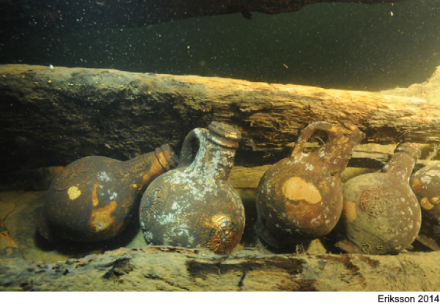History
Discovery
The wreck was discovered in 2003 by an offshore surveying company and checked out by a group of professional divers. They reported the discovery of pottery and glass from the 17th century to the Swedish National Maritime Museum (SMM) in Stockholm.
In 2007 and 2008, the site was surveyed by maritime archaeologists from the SMM, Södertörn University and the University of Southampton. The direct survey method was employed and wood samples for a dendrochronological analysis were taken, which indicated a provenance from north-eastern England and a date after 1613. As the sample contained no sapwood, the actual date of the vessel had to be considerably later. Aside from the provenance of the wood, an English influence in the shipbuilding technique could be quite generally observed.
Identification
The decisive clues for the vessel's identification were discovered in the Swedish naval archives. In 2018, the maritime archaeologist Dr. Niklas Eriksson tentatively associated the 'Edesö Wreck' - as it was known until then - with a small frigate named Bodekull of the Swedish Royal Navy, which sank with a cargo of flour.

Description
Despite the vessel's modest size, it had several features reminiscent of a warship, like armament and gun ports. These observations matched with the building of struss-type army transport ships at this time. These were ordered by King Karl X Gustav of Sweden to invade Denmark, but after his death in 1660 the plans for an invasion fleet were scrapped and the half-finished struss-type vessels were converted into small frigates instead. The English influence could be explained by the presence of the English master shipwright Thomas Day who supervised the building of struss-type vessels and may have imported also some building material from his home country.

While the dendrochronological date provided only an imprecise terminus post quem, finds like bartman jugs (also called bellarmines) indicated a date in the latter half of the 17th century, which facilitated the identification with the Bodekull through archival research.

| Master | Oluf Styff |
|---|---|
| Length | 65 ½ feet (20 m) |
| Beam | 19 ¾ feet (6 m) |
Status
Wrecks of ships that sank before 1850 are considered ancient monuments and are protected under the Swedish Historic Environment Act (Kulturmiljölagen). An additional protection was put in place by the county administration by prohibiting diving and anchoring at the wreck site. The wreck site is part of the Dalarö Skeppsvraksområde, a maritime cultural reserve, in which several historic wreck sites are included.
As part of the EU-funded Baltacar Project, a strategy was devised to open up historic wreck sites to the public, where diving is normally prohibited. As a direct outcome of this project, the wreck site can be visited accompanied by underwater guides employed by licensed diving services. Non-divers were also given the opportunity to experience the wreck by the creation of a 3D-model, seen below.
The 3D-model of the wreck.
References
- Eriksson, N. (2014).
The Edesö Wreck: the hull of a small, armed ship wrecked in the Stockholm archipelago in the latter half of the seventeenth century.
International Journal of Nautical Archaeology, 43.1.
pp 103-114. - Eriksson, N. (2018).
A New View of the ‘Edesö Wreck’: identifying the Swedish naval vessel Bodekull, built 1659–1661 and sunk 1678 from written sources.
International Journal of Nautical Archaeology, 47.2.
pp 391-404. - Eriksson, N. (2018).
Invasionsfartyget som blev en mjölskuta: identifieringen av ”Dalarövraket” som strussen Bodekull (1661-1678).
Forum Navale, 74.
pp 12-53. - Eriksson, N. (2021).
Baltic and east European shipbuilding influences in the Swedish Empire: tracing local and inter-regional shipbuilding traditions from the armed vessel Bodekull, built 1659-1661 and sunk 1678.
Marseilles. - Baltacar Project.
Dalarö Dive Park.